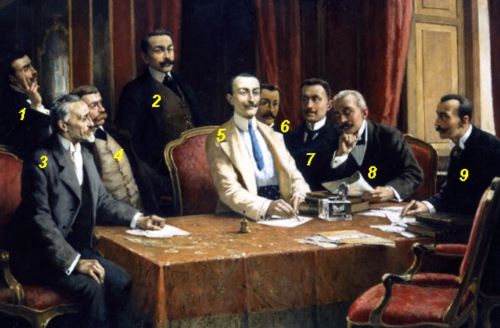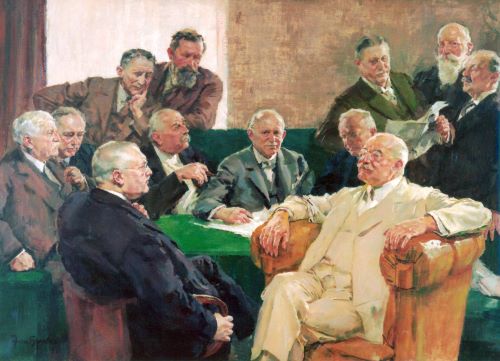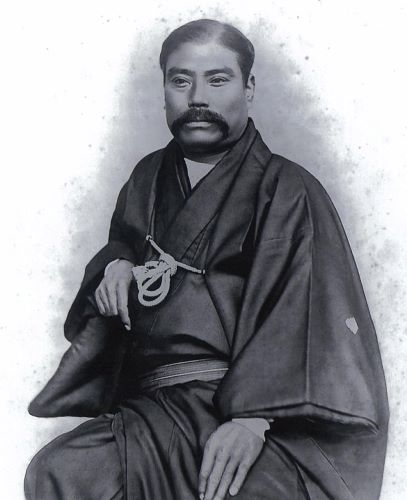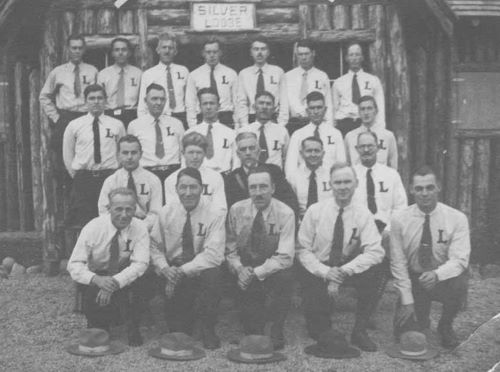

A history of the relationship between fascist regimes and corporations.

By Matthew A. McIntosh
Public Historian
Brewminate
Introduction
The 20th century witnessed the rise and fall of fascism as a political ideology and governing system. It was an era of global industrial expansion, the consolidation of corporate power, and sweeping economic transformations. A less often discussed but critical aspect of this history is the relationship between fascist regimes and corporations. While fascism is typically understood as a far-right, authoritarian nationalist ideology, it also had a complex and sometimes symbiotic relationship with capitalism and corporate interests. In many cases, corporations enabled, supported, or directly collaborated with fascist governments for profit, protection, and privilege. Here I examine the nature of that relationship across several national contexts, focusing particularly on Nazi Germany, Fascist Italy, and to a lesser extent, developments in the United States, Japan, and Spain. We explore how fascist regimes used corporate power, how corporations in turn benefited from fascism, and what this reveals about the intersection of political extremism and economic systems in the modern era.’
Fascism: Core Ideology and Economic Theory
Before examining the role of corporations, it is important to define what fascism is and is not. Fascism emerged in early 20th-century Europe as a response to liberal democracy, socialism, and the perceived failures of capitalism. It was deeply nationalist, authoritarian, militaristic, and often racist. Economically, however, fascism defies easy categorization.
Unlike socialism, fascism did not advocate for the abolition of private property or the nationalization of all industries. Instead, it sought to subordinate the economy to the interests of the nation-state. Benito Mussolini’s Italy and Adolf Hitler’s Germany both promoted a kind of corporatist economy, in which the state mediated between labor and capital under a nationalist framework. While fascist regimes claimed to be anti-capitalist and anti-bourgeois in rhetoric, in practice, they often maintained close relationships with business elites and major corporations. This created a hybrid system sometimes described as state capitalism, corporate statism, or authoritarian capitalism.1
Italy: The Birthplace of Fascist Corporatism

Benito Mussolini’s rise to power in Italy in 1922 marked the first instance of fascism becoming a governing ideology. Mussolini, a former socialist, turned sharply against Marxism and democracy, advocating instead for a totalitarian state that would resolve class conflict through a corporate system.
Under the fascist regime, the Italian state established a “corporate state” in which representatives of workers and employers were grouped into state-supervised corporations organized by sector (agriculture, industry, etc.).2 While this system was portrayed as a revolutionary alternative to both socialism and liberal capitalism, it effectively neutered independent labor unions and gave considerable power to industrial leaders. Strikes were outlawed, wages were set by state decree, and labor lost its autonomy.
Large industrialists, such as Fiat’s Giovanni Agnelli, welcomed this system. Fascism provided stability, suppressed labor unrest, and promised state contracts for war production.3 Though the corporatist system was inefficient and largely symbolic in many areas, it allowed Mussolini to maintain the façade of unity while relying on private enterprise to maintain industrial productivity.
Germany: The Nazi-Corporate Nexus

The relationship between corporations and the Nazi regime in Germany was even more robust and consequential. When Hitler came to power in 1933, Germany was still suffering from the Great Depression. Hitler’s economic policies included massive public works programs (e.g., the Autobahn), rearmament, and later, a full-scale war economy, all of which required the cooperation of major corporations.4
German industrial giants such as IG Farben, Siemens, Krupp, Volkswagen, and Daimler-Benz collaborated enthusiastically with the Nazi regime. In exchange for state contracts, tax breaks, and suppression of unions, these firms supported the regime’s militarization, Aryanization (the expropriation of Jewish-owned businesses), and war efforts.5
IG Farben, one of the largest chemical conglomerates in the world at the time, played a particularly heinous role. It produced Zyklon B, the gas used in extermination camps, and operated factories near Auschwitz using slave labor from concentration camp prisoners.6 Similarly, Krupp manufactured arms and utilized forced labor, while Volkswagen was established under Nazi sponsorship to produce the “people’s car,” only later becoming a mass consumer brand.7
While Hitler railed against capitalism in rhetoric, especially in his early speeches, in practice he accommodated and empowered industrialists. In fact, many German business leaders supported Hitler early on as a bulwark against communism.8 The Reichstag Fire Decree and Enabling Act of 1933 were seen by business leaders as stabilizing actions that would create an environment conducive to profit and expansion.9
Spain and Japan: Authoritarian Capitalism Elsewhere

In Franco’s Spain and imperial Japan, similar patterns emerged. In Spain, General Francisco Franco’s regime relied heavily on major landowners, financiers, and industrialists, although it lacked the ideological coherence or corporatist structure of Italy or Germany.10 The Spanish economy remained largely agrarian and underdeveloped until the mid-20th century, but the regime still suppressed labor rights and maintained close ties with business elites.
Japan, meanwhile, had a long history of state-corporate collaboration going back to the Meiji era. During its militarist expansion in the 1930s and World War II, major conglomerates known as zaibatsu (e.g., Mitsubishi, Mitsui) profited enormously from imperial conquest, forced labor, and government contracts.11 The Japanese state and business elites formed a militarized, hierarchical economic system that bore many fascist characteristics in its authoritarianism and nationalism.
The United States: Corporatism without Fascism?

The United States did not succumb to fascism, but during the 1930s and 1940s, some American corporations and business leaders exhibited troubling sympathies. Industrialists like Henry Ford expressed anti-Semitic views and had financial ties to Nazi Germany; Ford’s company maintained operations in Germany during the war.12 IBM leased punch-card technology to the Nazi government, which was used in population censuses, including those tracking Jews.13
At home, the New Deal sparked fears among some in the business class that President Franklin Roosevelt was leading America toward socialism. In response, a few corporate interests flirted with authoritarian ideas, and fringe groups such as the Silver Legion (an American fascist movement) briefly emerged. Although these movements never gained serious traction, they highlight the complex entanglement between corporate anxieties and authoritarian impulses.14
Corporations and Fascism: Mutually Beneficial or Morally Compromised?
The collaboration between fascist regimes and corporations raises enduring ethical and political questions. On the one hand, corporations benefited from fascist policies that suppressed labor rights, stabilized markets, and expanded state contracts. On the other, fascist regimes depended on corporate cooperation to carry out rearmament, mass mobilization, and, in the case of Nazi Germany, genocide.
This dynamic was not always based on shared ideology, many corporations were indifferent to fascist doctrine, but rather on opportunism, profit motive, and a willingness to operate within authoritarian frameworks. In some cases, business leaders genuinely supported fascism as a defense against communism or liberal democracy; in others, they simply adapted to prevailing political winds.15
Postwar Reckoning and Historical Legacy
After World War II, some corporate leaders were tried at Nuremberg, particularly those associated with IG Farben and Krupp.16 Yet most corporations that had supported fascist regimes were not permanently penalized. Many rebranded, rebuilt, and reintegrated into postwar capitalist economies. In West Germany and Japan, for example, U.S. reconstruction efforts emphasized rapid economic recovery, often at the expense of full accountability.17
Today, the historical relationship between fascism and corporations is often overlooked in public discourse. Yet the legacy remains relevant, especially in discussions about the social responsibilities of corporations, the dangers of authoritarian politics, and the conditions under which private enterprise may align itself with oppressive regimes.
Conclusion
The relationship between corporations and fascist regimes in the 20th century was marked by complicity, pragmatism, and shared interests. While fascist ideology promised a new order free from the perceived chaos of capitalism and class conflict, in practice it preserved and empowered corporate power within an authoritarian framework. Corporations, in turn, enabled fascist regimes to build militarized economies, suppress dissent, and even commit atrocities. Understanding this history is not merely academic, it has contemporary implications. In an era where authoritarian populism is resurgent in some parts of the world, the role of corporations in enabling or resisting undemocratic movements is once again a pressing concern. The 20th century teaches that the line between economic pragmatism and moral compromise can blur quickly, and that vigilance is required to keep the power of capital accountable to democratic values.
Appendix
Endnotes
- Stanley G. Payne, A History of Fascism, 1914–1945 (Madison: University of Wisconsin Press, 1995).
- Alexander J. De Grand, Italian Fascism: Its Origins and Development (Lincoln: University of Nebraska Press, 2000).
- Paul Corner, The Fascist Party and Popular Opinion in Mussolini’s Italy (Oxford: Oxford University Press, 2012).
- Adam Tooze, The Wages of Destruction: The Making and Breaking of the Nazi Economy (New York: Viking, 2006).
- Peter Hayes, Industry and Ideology: IG Farben in the Nazi Era (Cambridge: Cambridge University Press, 1987).
- Joseph Borkin, The Crime and Punishment of IG Farben (New York: Free Press, 1978).
- Richard J. Evans, The Third Reich in Power (New York: Penguin Press, 2005).
- Henry A. Turner, German Big Business and the Rise of Hitler (Oxford: Oxford University Press, 1985).
- Ian Kershaw, Hitler, 1889–1936: Hubris (New York: W.W. Norton, 1998).
- Stanley G. Payne, Franco and Hitler: Spain, Germany, and World War II (New Haven: Yale University Press, 2008).
- Chalmers Johnson, MITI and the Japanese Miracle: The Growth of Industrial Policy, 1925–1975 (Stanford: Stanford University Press, 1982).
- Neil Baldwin, Henry Ford and the Jews: The Mass Production of Hate (New York: PublicAffairs, 2001).
- Edwin Black, IBM and the Holocaust: The Strategic Alliance between Nazi Germany and America’s Most Powerful Corporation (New York: Crown, 2001).
- Daniel Bell, The Radical Right (Garden City: Doubleday, 1963).
- Robert O. Paxton, The Anatomy of Fascism (New York: Alfred A. Knopf, 2004).
- Telford Taylor, The Anatomy of the Nuremberg Trials (New York: Knopf, 1992).
- Günter Bischof and Dieter Stiefel, eds., 80 Dollars to Reform a Country: The US Aid Program and Postwar Austria (Innsbruck: Studien Verlag, 1999).
Bibliography
- Baldwin, Neil. Henry Ford and the Jews: The Mass Production of Hate. New York: PublicAffairs, 2001.
- Bell, Daniel. The Radical Right. Garden City: Doubleday, 1963.
- Bischof, Günter, and Dieter Stiefel, eds. 80 Dollars to Reform a Country: The US Aid Program and Postwar Austria. Innsbruck: Studien Verlag, 1999.
- Black, Edwin. IBM and the Holocaust: The Strategic Alliance between Nazi Germany and America’s Most Powerful Corporation. New York: Crown, 2001.
- Borkin, Joseph. The Crime and Punishment of IG Farben. New York: Free Press, 1978.
- Corner, Paul. The Fascist Party and Popular Opinion in Mussolini’s Italy. Oxford: Oxford University Press, 2012.
- De Grand, Alexander J. Italian Fascism: Its Origins and Development. Lincoln: University of Nebraska Press, 2000.
- Evans, Richard J. The Third Reich in Power. New York: Penguin Press, 2005.
- Hayes, Peter. Industry and Ideology: IG Farben in the Nazi Era. Cambridge: Cambridge University Press, 1987.
- Johnson, Chalmers. MITI and the Japanese Miracle: The Growth of Industrial Policy, 1925–1975. Stanford: Stanford University Press, 1982.
- Kershaw, Ian. Hitler, 1889–1936: Hubris. New York: W.W. Norton, 1998.
- Paxton, Robert O. The Anatomy of Fascism. New York: Alfred A. Knopf, 2004.
- Payne, Stanley G. A History of Fascism, 1914–1945. Madison: University of Wisconsin Press, 1995.
- ———. Franco and Hitler: Spain, Germany, and World War II. New Haven: Yale University Press, 2008.
- Taylor, Telford. The Anatomy of the Nuremberg Trials. New York: Knopf, 1992.
- Tooze, Adam. The Wages of Destruction: The Making and Breaking of the Nazi Economy. New York: Viking, 2006.
- Turner, Henry A. German Big Business and the Rise of Hitler. Oxford: Oxford University Press, 1985.
Originally published by Brewminate, 06.17.2025, under the terms of a Creative Commons Attribution-NonCommercial-NoDerivatives 4.0 International license.


